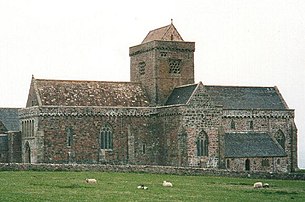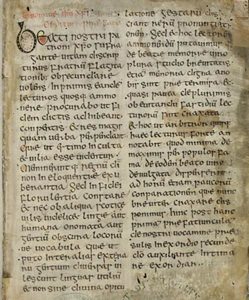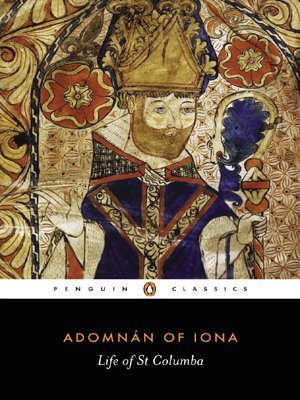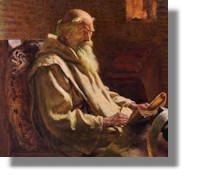Adomnán
Adomnan or Adamnan [' aðavna ː n] ( * 628, † 23 September 704) was an Irish saint, hagiographer and the ninth abbot of Iona ( 679-704 ).
He is particularly known for his two major works as an author: The Life of Saint Columba ( " The Life of Saint Columba " ) and De Sanctis locis ( " over the holy places "). Furthermore, he was ranked as the herald of the "Law of the Innocents " ( "Law of Innocents ", also Adomnáin Cain, " Adomnáns Canon " ) known. His academic achievements that have already been praised by contemporaries such as Bede and Ceolfrith, he owes a probably enjoyed exclusively in his home training. In reports of those contemporaries he is described as a man with a relatively high critical standard, a large learning in relation to the scriptures and meticulous attention to detail in the treatment of his material.
Etymology
To date, various sources have used many different types of notation of the Holy Adomnán. The most prominent variants are Adomnán and Adamnan. The spelling Adomnán was probably the spelling he used himself and there are evidence that this notation prevailed at least until the 10th century. But already in the Old Irish period, the middle vowel between non- palatal consonants changed to a -a-, which led to the etymology of "little Adam ". Adomnáns name has been associated with less than 30 locations. In Ireland is a popular form of his name Saint Eunan, derived from the Gaelic -Irish Naomh Adhamhnán. Alone in his native County Donegal are at least four institutions known to bear the name of St. Eunan, including the St. Eunan 's Cathedral, the Church of Ireland in Raphoe, where Adomnán has even worked, and the Roman Catholic St. Eunan 's Cathedral Letterkenny. In terms of Scottish place names, his name was modified in Eodhnan and similar forms. There was even a church of Adomnán at Forglen in Banffshire, which may already exist to Adomnáns lifetime.
Curriculum vitae
Adomnán was born around 628 and was the son of Ronan, son of Tinne and Ronnat of the Cenél n Enna. As a descendant of Colman mac Setna, the ancestors of the kings of Cenél Conaill and cousin of Columba, he belonged to the family of the latter. His place of birth can be determined with some certainty to the county Donegal. Some sources, however, limits this further one to the district in the east of Donegal Raphoe and some on Tir Aedna ( Tirhugh ) in the south of Donegal. However, the sources are located at the point agreed that Adomnán has not received his early education at Iona, as he personally knew no abbot before Failbe ( 669-679 ). Some indicate that he may have studied at Clonard before its inclusion in the Community Kolumbans. He was appointed in the year 679 the abbot of the monastery of Iona, ninth in the footsteps of its founder Columban. Adomnán had probably already 673-676 responsibility about the monastery, while his predecessor Failbe was staying in Ireland.
Early in his official dignity, probably around 686, got Adomnán Arculf know, a Gallic bishop, who had traveled to the Holy Land and other countries of the East and a while staying in Iona. He provided Adomnán with information about the sacred places of this country, which led to his first major work: De Sanctis Locis. His family ties to Ireland and his position as head of the community of monks Kolumbans led him on diplomatic and political missions in Ireland and Northumbria. So Adomnán visited the King Aldfrith of Northumbria in 686 in the function of an Irish ambassador to the release of 60, two years earlier by his predecessor Ecgfrith caught ensure Irish. During this mission, he spent some time with the abbot Ceolfrith in Wearmouth or Jarrow and was persuaded to take over the Roman rules with regard to the time of the Easter holidays and the tonsure. He also managed to convert the Iona subordinate monks in Ireland to these rules, but beat his efforts to convince those on Iona itself of the need for such reforms will fail.
According to his contemporaries Bede - which during Adomnáns visit Wearmouth was a monk there - he presented King Aldfrith a copy of De Sanctis Locis, but is not sure if he did this on his first visit, or only at His Second in 688 Adomnán has at least twice during his lifetime visited, first in 691 and again 697 during his second visit, he preached the Law of the Innocents Ireland. Apparently he remained from 697 in Ireland and returned in the summer of 704 back to Iona. According to records there Adomnáns died in Iona, on 23 September 704, at the age of 77 years.
Works
Adomnán was known for three works from his pen: The most important biography / hagiography of the founder of Iona, the Life of Columba ( Life of Columba - "Life of Columba " ), the collection of reports of sacred places, De Sanctis Locis ( " About the Holy places " ) and the " Law of the Innocents ".
The Life of Columba is less a biography of Saint Columba, but rather a collection of his miracles in God's service. It was probably written in Iona and was completed no earlier than 688, you may either 690 or the year 696 or later, which is indicated by various passages of the Vita. However, completion prior to 697 is considered safe because Adomnán has not been present from this year until shortly before his death in Iona.
The "Law of the Innocents " - Cain Adomnáin, " Adomnáns Canon " was promulgated in 697 at a synod, which was held in Birr in County Offaly. It has the aim of protecting women, children and men of holy order against acts of violence in war and peace. Penalties should be partially paid to " Adomnán and his community ", so to Kolumbans community of monks. Even if some other works were allegedly written wholly or partly of Adomnán, are the two most important, De Sanctis Locis and the Life of Columba, the only known works that can be attributed to him with sufficient certainty.


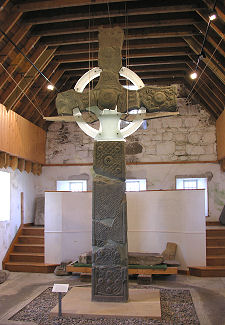
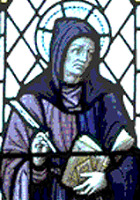

.jpg/100px-Saint_Patrick_(window).jpg)

